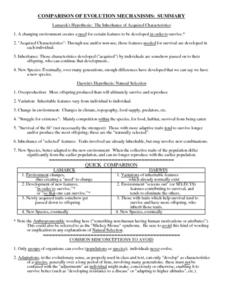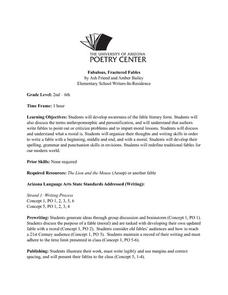Curated OER
Anthropomorphic Writing
In this writing worksheet, students discover anthropomorphic writing-- giving human characteristics to an inanimate object. Students write a short passage and draw a picture of a laughing leaf.
National Gallery of Canada
Morphosis
Experience anthropomorphism and metamorphosis in action with flipbooks! Instead of giving human characteristics to animals, though, pupils will show a transformation from human to animal or vise versa through their drawings. The...
TED-Ed
A Brief History of Religion in Art
Did you know that some languages have no word for art? The English language does and the narrator of this short video discusses the aesthetic dimension of religious art as it "visually communicates meaning beyond language."
Curated OER
Exploring Animals in Literature
Celebrate Be Kind to Animals Week while teaching empathy and allegory with creature-related texts
Pittford Schools
Literary Devices, Techniques, and Elements
What's the difference between a speaker and an author? What's an example of anthropomorphism? Clarify the meanings of literary devices, elements, and techniques with a comprehensive glossary of terms.
Curated OER
Life's Lessons: Survival of the Fittest
Students analyze Jack London's use of anthropomorphism to identify the importance of adaptability in life. In this literature lesson, students use the novel The Call of the Wild to identify key elements in survival. Students...
EngageNY
Grade 9 ELA Module 3, Unit 1, Lesson 4
Can dogs feel shame? Explore the anthropomorphic connection between human emotions and animal behavior—or lack thereof—with a lesson about Temple Grandin's book, Animals in Translation. Ninth graders continue a close reading of chapter...
Curated OER
Investigative Case - Protistan Tales of Atlantic White Cedar Swamps
Students use this WebQuest to explore the vast diversity of microbes, especially those microbes of the Atlantic Cedar Swamps. They tell a story about the protests of the Atlantic Cedar Swamp in the form of anthropomorphism.
Curated OER
Comparison of Evolution Mechanism
In this comparison of evolution worksheets, students read information about Lamarck's hypothesis of evolution and Darwin's hypothesis of evolution. Students then rate the scenarios given as either supportive of Lamarck's or Darwin's...
Kenan Fellows
What Element Would You Be?
Primo Levi wrote a collection of short stories comparing his life from Italy to Auschwitz to elements in the periodic table. Pupils read an excerpt from his book and research the characteristics of various elements. Then, they make a...
Reed Novel Studies
The Wind In The Willows: Novel Study
True friends stick together. In the case of The Wind In The Willows, the friends just happen to be a toad, mole, rat, and badger who team up to beat the weasels. The resource covers the first chapter of their raucous adventures. Scholars...
Curated OER
Ecology and the Conservation of Natural Resources
Students examine the habits of various organism and evaluate the need for conserving natural resources. They role-play as migrating birds traveling between habitats encountering hazards along the way. They observe animals in a...
Curated OER
The Laughing Leaf
Students demonstrate real-object writing. They discuss a leaf that has human attributes, and using a real leaf write a story about a leaf that tells them a joke, and create an illustration of themselves and their leaf.
Curated OER
Fabulous, Fractured Fables
Elementary schoolers develop an awareness of the literary form known as the fable. They explore how authors write fables to pass along moral lessons. After reading and discussing many famous fables embedded in the plan, learners attempt...
Curated OER
Jack London's The Call of the Wild: "Nature Faker"?
Students examine how Jack London tells a story from the point of view of an animal. They read and discuss primary source documents, analyze text and excerpts, complete a chart, and explore various websites.
Curated OER
Animal Rights Vs. Animal Welfare - Understanding the Issue
Pupils explore the difference between animal rights and animal welfare. They take a field trip to a farm to explore the producing animals for human use. After researching and collecting information from animal welfare/rights...
Curated OER
Cartoons for the Classroom: Putting a Face on Our Fears
In this current events worksheet, students analyze a political cartoon about the nuclear war threat and respond to 3 talking point questions.
Curated OER
Jack London's The Call of the Wild: "Nature Faker"?
Students take a stand on whether or not London could be dubbed a "nature faker." They support their position with evidence either historical or from the text. Students write an essay, complete with hypothesis and textual support, on...
Curated OER
Protein Synthesis Activities
Young scholars participate in a teacher-guided activity to teach about protein synthesis. Student roles include one person as the DNA molecule, another is a single stranded sequence of complementary mRNA.
Curated OER
White Fang by Jack London
In this online interactive reading comprehension worksheet, students respond to 6 short answer and essay questions based on White Fang. Students may also access an online quiz on the selection using the link at the bottom of the page.
Curated OER
The Call of the Wild Vocabulary Exercise
In this vocabulary learning exercise, learners match words to definitions and complete a word search for vocabulary from The Call of the Wild. Students complete 10 words for each exercise.
Curated OER
Honey Bee Language Arts And Literature
Students see how nature and honey bees are presented in literature. They find and read poetry that include references to bees. Have them write their own poetry or Haiku.
Curated OER
Greek Mythology: All in the Family
Twelfth graders compare/contrast the Greek myth to explain an aspect of nature. They create an explanatory myth about some aspect of nature and design a mythological business card using Microsoft Word.
Curated OER
Personification Stories
Students create a clay object in which they are to personify. They use their own personal experiences to help the viewer imagine what it would be like to be that particular object. They also watch videos of fables to help them with...

























